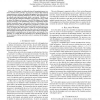Free Online Productivity Tools
i2Speak
i2Symbol
i2OCR
iTex2Img
iWeb2Print
iWeb2Shot
i2Type
iPdf2Split
iPdf2Merge
i2Bopomofo
i2Arabic
i2Style
i2Image
i2PDF
iLatex2Rtf
Sci2ools
ICPPW
2002
IEEE
2002
IEEE
Quantitative Analysis of Transmission Power Control in Wireless Ad-hoc Networks
Abstract—In this paper, we address the issue of transmission power control in wireless ad-hoc networks. In general, it is assumed that minimum transmission power achieves the optimal throughput of an ad-hoc network because it produces minimum interference. However, this assumption can be realized under high node density which is not typical. Therefore, we show that using the minimal transmission range might not always results in optimal throughput performance. Using both throughput and throughput per unit energy as the optimization criteria, we demonstrate that the optimal transmission power is generically a function of the number of stations, the network size, and the traffic load. In particular, we observe that the optimal power is a function of the network load for typical network scenarios. To analyze these observations, we define an analytical throughput model using three factors: spatial re-use, hop count, and contention time. The throughput model supports the results of obse...
| Added | 14 Jul 2010 |
| Updated | 14 Jul 2010 |
| Type | Conference |
| Year | 2002 |
| Where | ICPPW |
| Authors | Seung-Jong Park, Raghupathy Sivakumar |
Comments (0)

